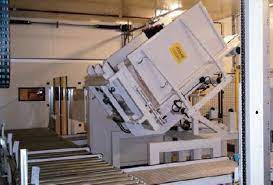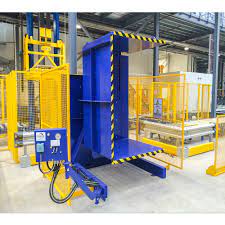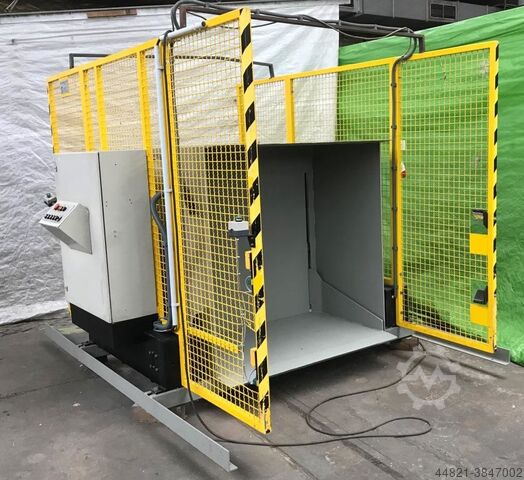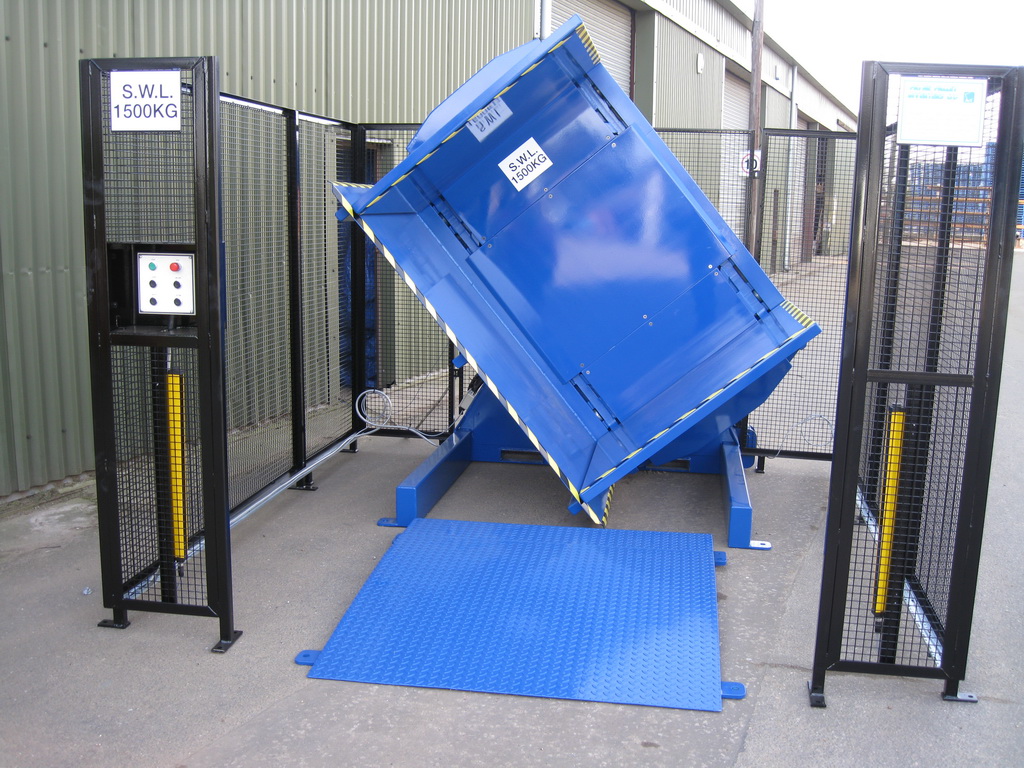Is Your Spain Factory Struggling with CE-certified machines for food-grade operations? Try a Pallet Changing Machine
Running a food-grade operation in Spain means you face immense pressure. You need to meet some of the strictest hygiene standards in the world. You also have to protect your workers and your brand. Are you constantly worried about contamination from incoming wooden pallets? Do you spend too much time and money on manual processes that are slow, unsafe, and unreliable? It's a frustrating position. This constant struggle can feel like a major block to your growth, creating bottlenecks and risks that you simply can't afford. The fear of a failed audit, a rejected shipment, or a workplace accident is always in the back of your mind.
A CE-certified pallet changing machine is your direct solution. It solves these challenges for food-grade operations in Spain by automating the transfer of goods. The machine takes your products from external, non-hygienic wooden pallets and moves them to clean, in-house plastic or stainless steel pallets. This single step eliminates a major contamination source, removes risky manual handling, and ensures your factory fully complies with strict European food safety and machinery regulations.

I know what you might be thinking. "Another piece of equipment to buy, integrate, and maintain." I understand that perspective. I've been an engineer and a factory owner for many years. But this isn't just another machine. This is a strategic investment in your factory's core process. It is a solution that tackles hygiene, safety, and efficiency all at once. Let's look closer at how this equipment can solve some of your biggest headaches and help you build a stronger, more profitable business.
How can a pallet changer solve hygiene compliance issues in Spain's food industry?
You know the rules better than anyone. Regulations from the European Food Safety Authority (EFSA) and standards like BRCGS and HACCP are not suggestions; they are requirements. Wooden pallets, while cheap for transport, are a serious liability inside your clean facility. They can harbor mold, bacteria, pests, and absorb moisture. Are you constantly battling these invisible threats to keep your product pure? This fight creates stress and adds complex, manual steps to your receiving process. A single contaminated pallet can compromise an entire batch, leading to waste and financial loss.
A pallet changer directly solves hygiene compliance by creating a clean break between your external supply chain and your internal high-care production area. It works as a gatekeeper. It allows you to receive goods on standard wooden pallets and then automatically transfers the entire product stack onto a sanitized, food-grade pallet made of plastic or stainless steel. This action ensures that the dirt, debris, and potential contaminants from the outside world never enter your clean zone.

Creating a Physical Barrier to Contamination
The fundamental job of a pallet changer in a food-grade environment is to act as a physical barrier. Think of it as the secure entrance to your high-care zone. Products arrive at your receiving dock on standard, often low-quality, wooden pallets. These pallets have been everywhere. They've sat in warehouses, on trucks, and been exposed to rain and pests. They are a primary vector for contamination. Manually re-stacking goods from these pallets onto clean ones is slow and introduces human error and further contamination risk.
A pallet changer automates this entire process. The machine gently clamps the product load, inverts or pushes it, removes the wooden pallet, and places the load onto a clean, sterilized plastic or stainless steel pallet. This process happens within the machine, in a controlled way. The dirty pallet is ejected and never crosses the threshold into your production area. This simple, automated exchange eliminates countless hygiene risks. I once visited a client's dairy facility in Spain before they installed one of our machines. I saw two workers manually moving heavy cheese blocks from a splintered wooden pallet to a plastic one. The risk of wood splinters, dust, and bacteria entering the product was incredibly high. After they installed a pallet inverter, they created a clear red line on their floor. Dirty pallets never crossed it. Their audit scores improved almost immediately.
Supporting Your HACCP and BRCGS Systems
Meeting global food safety standards like HACCP (Hazard Analysis and Critical Control Points) and BRCGS is essential for any Spanish food exporter. A pallet changer is not just a piece of hardware; it is a tool that directly supports your compliance with these standards. It becomes a designated Critical Control Point (CCP) in your HACCP plan.
Here is how it helps you meet specific requirements:
| Standard Requirement | How a Pallet Changer Helps |
|---|---|
| Foreign Body Control | It completely removes the wooden pallet, which is a common source of foreign bodies like wood splinters, nails, and staples. |
| Pest Control | It prevents pallets that may carry insects or rodent contamination from entering the processing and storage areas. |
| Microbial Control | It stops mold, fungi, and bacteria that thrive in damp wood from being introduced into your clean environment. |
| Allergen Segregation | If you handle products with different allergens, a dedicated pallet changer can ensure that loads are transferred to color-coded, allergen-specific pallets, preventing cross-contamination. |
| Traceability & Process Control | An automated system provides a consistent, repeatable process. This is far more reliable and easier to document for an audit than a variable manual process. |
By integrating a pallet changer, you are creating a robust, defensible system. You can prove to auditors that you have a physical, automated control measure in place to mitigate one of the most common sources of contamination in the food supply chain.
What makes a pallet changer CE-certified and why is it crucial for Spanish factories?
You see the "CE" mark on equipment all the time. It is easy to think of it as just a sticker. But do you really understand what it means for your factory's safety, your legal obligations, and your insurance? Sourcing equipment from outside the EU without a valid CE mark is a massive gamble. It can lead to orders from the Inspección de Trabajo y Seguridad Social to shut down the machine, significant fines, and, worst of all, a serious accident involving one of your team members. The perceived cost savings are never worth this level of risk.
A pallet changer becomes CE-certified only after it has been proven to meet the European Union's essential requirements for health, safety, and environmental protection. The core of this is the Machinery Directive 2006/42/EC. This is not a simple checklist. It is a comprehensive set of rules that governs everything from the design of safety guards to the quality of the electrical panel and the clarity of the user manual. For any factory in Spain, or anywhere in the EU, using CE-certified machinery is not a choice. It is a fundamental legal requirement to ensure a safe workplace.

The Deep Meaning of the Machinery Directive
The CE mark is a manufacturer's declaration that their product complies with all relevant EU directives. For a pallet changer, the Machinery Directive 2006/42/EC is the most important one. It forces manufacturers like me to design safety into the machine from the very beginning. It's not an afterthought.
Here are some key things a CE-certified machine must have:
- Comprehensive Risk Assessment: The manufacturer must identify every possible hazard the machine could pose during operation, maintenance, and cleaning. They must then design solutions to eliminate or minimize these risks. This includes mechanical hazards (crushing, shearing), electrical hazards, and ergonomic hazards.
- Essential Safety Components: This is about physical hardware. A CE-certified pallet changer will have interlocked safety gates. If an operator opens a gate while the machine is running, it must stop immediately. It will have light curtains that create an invisible safety barrier. If a person or object breaks the beam, the machine halts. It will have clearly marked, easily accessible emergency stop buttons.
- Control System Reliability: The machine's control system (the PLC) must be designed to be fail-safe. A simple component failure should not lead to a dangerous situation. The safety circuits are often redundant, meaning there is a backup if one part fails.
- Full Technical Documentation: A CE-certified machine comes with a "Technical File." This file contains all the proof of compliance: risk assessments, engineering drawings, electrical schematics, and parts lists. It also includes a detailed user manual written in the language of the end-user—in your case, Spanish. This manual must cover safe operation, maintenance, and troubleshooting.
Why This is Non-Negotiable for You in Spain
Operating a non-certified machine in Spain exposes your business to severe consequences. It is not a matter of "if" you will have a problem, but "when."
| Aspect | CE-Certified Machine | Non-Certified Machine |
|---|---|---|
| Legal Status | Fully legal to operate in Spain and across the EU. Complies with national labor laws. | Illegal to put into service. Can be locked down by safety inspectors. |
| Worker Safety | Designed with integrated, fail-safe safety features like light curtains and interlocked guards. | Safety features are often optional, easily bypassed, or non-existent. High risk of accidents. |
| Insurance | Your liability insurance will cover incidents involving the machine. | Your insurer may deny a claim for an accident involving a non-compliant machine. |
| Resale Value | Holds its value because it can be legally sold and operated anywhere in the EEA. | Has very little to no resale value. It is essentially scrap metal outside its original location. |
| Support | Comes with a Declaration of Conformity and a complete technical file. Supported by a manufacturer who understands EU regulations. | Often arrives with poor or no documentation. The manufacturer may not understand or care about their legal obligations in the EU. |
When I started my own factory, I made a rule: no compromises on safety. A machine has to protect my people first. The CE mark is the first sign I look for. It tells me the manufacturer has taken safety as seriously as I do. It is a partnership built on a shared commitment to a safe and productive workplace.
How does a pallet changing machine integrate into an existing food-grade production line?
You have a finely tuned production line. The flow of materials is critical. You have likely spent years and significant capital optimizing it. The idea of adding a new piece of equipment can be daunting. You worry about creating a new bottleneck, requiring a massive and costly reconfiguration of your floor plan, or facing a complex IT project. The fear of disruption is real and can prevent you from making a change that you know is necessary.
A pallet changing machine is designed for flexible integration. It can be implemented smoothly without turning your factory upside down. The key is to plan the integration as a collaborative process between you and your equipment partner. A good partner will help you decide between a simple standalone setup or a fully automated inline system, ensuring it fits your space, your budget, and your throughput needs perfectly.

Choosing Your Integration Model: Standalone vs. Inline
The first decision is how the pallet changer will fit into your material flow. There are two primary models, each with its own advantages.
-
Standalone (Offline) System:
This is the simplest and most common integration method. The pallet changer is placed in a dedicated area, usually near the receiving dock and the entrance to the high-care zone. A forklift operator brings a pallet of incoming goods to the machine. The operator initiates the exchange cycle. Once complete, the forklift picks up the load on the new, clean pallet and takes it into the production area.- Pros: Lower initial investment, high flexibility in placement, minimal disruption to existing conveyor lines.
- Cons: Relies on forklift traffic, throughput is limited by the forklift operator's speed, requires more manual labor than an inline system.
- Best for: Factories with lower to medium throughput, varied product types, or where existing infrastructure makes inline integration difficult.
-
Fully Integrated (Inline) System:
In this model, the pallet changer becomes a seamless part of your automated conveyor system. Pallets of incoming goods travel on a conveyor directly into the machine. The exchange happens automatically. The load then exits on a clean pallet onto another conveyor that leads into your production or warehouse system.- Pros: Fully automated, high and consistent throughput, reduces forklift traffic and labor costs.
- Cons: Higher initial investment, requires more detailed planning and space, less flexible once installed.
- Best for: High-volume operations, factories with existing conveyor systems, or new factory builds where automation can be planned from the start.
The Physical and Digital Integration Process
A successful integration is all about the details. As an engineer, this is the part I enjoy most. We work with our clients to ensure a perfect fit.
Physical Integration:
It starts with a layout drawing. We look at your factory's floor plan to find the optimal location. We consider the machine's footprint, the required safety zones around it, and the flow of forklifts and personnel. We check your floor's load-bearing capacity and your available utilities, like 3-phase power and compressed air. The goal is to place the machine where it enhances your workflow, not obstructs it.
Digital Integration (Industry 4.0 Ready):
Modern pallet changers are more than just mechanical devices; they are smart machines. The PLC (Programmable Logic Controller) that runs the machine can communicate with your factory's higher-level software.
| System | Communication Flow | Benefit |
|---|---|---|
| WMS (Warehouse Management System) | The WMS can send a pallet ID to the changer. The changer executes the swap and sends a "task complete" signal back to the WMS. | Full traceability. Your system knows exactly when the product was moved to a hygienic pallet. |
| MES (Manufacturing Execution System) | The changer can feed data into your MES, like cycle times and number of pallets changed. | Provides valuable Overall Equipment Effectiveness (OEE) data and helps you monitor performance. |
| ERP (Enterprise Resource Planning) | The data can flow up to your ERP, linking the physical material handling step with inventory and order data. | Creates a single source of truth for your entire operation, from receiving to shipping. |
This connectivity turns the pallet changer from an isolated island of automation into a fully integrated node in your smart factory.
What is the ROI of a pallet changer in a food-grade operation considering labor and safety?
As a business owner, every euro you spend must be justified. You are not buying machines; you are investing in capabilities. A pallet changer is a significant investment, and you need to see a clear and compelling Return on Investment (ROI). The initial price on the quotation can seem high, but you must look beyond that number. You need to analyze the hidden, ongoing costs of your current manual process and the tangible savings an automated solution will deliver.
The ROI of a pallet changer is powerful because it comes from multiple sources at once. You get direct savings from reducing labor. You get indirect savings from preventing product damage. And you get strategic value from improved safety and compliance. When you add it all up, the payback period is often much shorter than you think, typically falling between 18 and 36 months for most food operations.

Calculating Your Tangible Savings
These are the hard numbers you can easily calculate to build your business case. Let's break down the main categories.
- Labor Costs: This is usually the biggest and most immediate saving. How many people do you have manually re-stacking pallets? Let's say it takes two workers 15 minutes to manually transfer one pallet load. If they handle 10 pallets per hour, that's 30 minutes of every hour spent just on this task. That's one full-time employee's worth of labor. An automated pallet changer can be managed by one operator who only needs to spend a fraction of their time overseeing the machine.
- Product Damage: Manual handling is inconsistent. Workers get tired, they rush, and they can accidentally drop or damage boxes. This leads to unsaleable goods, waste, and rework. A pallet changer with a pressure-controlled clamping system handles every load with the same gentle, precise force. This drastically reduces damage. Even a 1% reduction in damage can translate to thousands of euros saved each year.
- Pallet Management Costs: Hygienic pallets (plastic or aluminum) are expensive. You don't want them leaving your facility. A pallet changer allows you to create a closed loop. You can receive goods on cheap, one-way wooden pallets and immediately transfer them to your high-value hygienic pallets, which never need to go outside. This eliminates the cost of lost or damaged hygienic pallets and the expense of managing a pallet pool with your suppliers.
A Sample ROI Calculation
Let's put some real numbers to this. This is a simplified example, but it shows how quickly the savings add up.
| Cost or Saving Area | Calculation | Annual Impact (€) |
|---|---|---|
| Labor Savings | 1.5 workers saved @ €30,000/year salary (incl. social costs) | €45,000 |
| Product Damage Reduction | 0.5% reduction on €5M annual product throughput | €25,000 |
| Pallet Cost Savings | 200 lost/damaged hygienic pallets avoided @ €80/pallet | €16,000 |
| Workplace Injury Reduction | 1 minor back injury avoided (lost time, admin costs) | €5,000 |
| Total Annual Savings | €91,000 |
Now, let's assume the total cost of a suitable, CE-certified pallet changer (including installation and training) is €150,000.
ROI Calculation:
- Payback Period = Total Investment / Total Annual Savings
- Payback Period = €150,000 / €91,000 = 1.65 years
This means the machine pays for itself in less than 20 months. After that, the €91,000 in savings goes directly to your profit margin every single year. And this calculation does not even include the immense financial value of avoiding a product recall or a major non-compliance fine, which could easily be more than the cost of the machine itself.
My Insights
I didn't start my career as a factory owner. I began as an engineer on the factory floor, with grease on my hands. I learned how machines work, but more importantly, I learned how work gets done. I saw the challenges that operators face every day—the unsafe shortcuts, the inefficient processes, the frustration of working with bad equipment. When I finally built my own factory, and later SHJLPACK, I carried those lessons with me.
Like you, when I look at a new piece of equipment, I don't just see a price tag. I see a potential solution to a problem. I ask myself the same questions you do: Will this make my team safer? Will this make our process more reliable? Will this make our business stronger and more competitive? Will it deliver a real return?
The problem you face in your Spanish food factory isn't really about wooden pallets. It's about controlling a critical process. The point where goods enter your facility is one of the most important control points you have. If you get it wrong, the consequences ripple through your entire operation, leading to contamination, waste, and risk. But if you get it right, you build a foundation of quality and safety that protects your product, your people, and your brand.
Choosing a pallet changer is about more than just the machine's specifications. It's about choosing the right partner. You need a partner who understands your industry. A partner who takes CE certification as seriously as you take food safety. A partner who will work with you to design a smooth integration, not just drop a machine on your doorstep. This is the reason I founded SHJLPACK. I wanted to do more than just sell machines. I wanted to share the knowledge I gained over decades to help other business owners solve these exact problems. My goal is to be that partner for you, to help you find the right total solution for your wrapping and handling needs.
Conclusion
A CE-certified pallet changer is a strategic tool for hygiene, safety, and efficiency. It helps your Spanish food-grade factory ensure compliance and directly boosts your operational bottom line.



